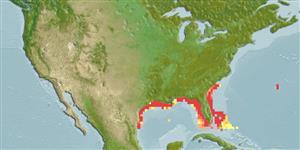>
Blenniiformes (Blennies) >
Dactyloscopidae (Sand stargazers)
Etymology: Dactyloscopus: Greek, daktylos = finger + Greek, skopein = to look (Ref. 45335).
Eponymy: Clarence Bloomfield Moore (1852–1936) was an American archaeologist, particularly noted for his studies of Native American sites. [...] (Ref. 128868), visit book page.
More on author: Fowler.
Environment: milieu / climate zone / пределы глубины / distribution range
экология
морской демерсальный; пределы глубины 3 - 35 m (Ref. 27742). Subtropical; 33°N - 24°N
Western Central Atlantic: North Carolina to Florida Keys and Texas in the Gulf of Mexico.
Size / Вес / Возраст
половая зрелость: Lm ? range ? - ? cm
Max length : 8.0 cm TL самец/пол неопределен; (Ref. 7251)
колючие лучи спинного плавника (общее число) : 11 - 13; колючие лучи анального плавника: 2; членистые (мягкие) лучи анального плавника: 30 - 35. Common amongst Dactyloscopidae: Small, elongate fishes. Head usually broad and deep, body tapering and compressed behind. Eyes on top of head, often protrusible; mouth moderate to large, oblique to vertical; upper and/or lower lips with fimbriae; jaw teeth minute, in 2 or more series; no teeth on roof of mouth (vomer and palatines). Opercular opening large, gill membrane free from isthmus; opercles membranous, large, usually overlapping on underside of head, typically fringed above with 2 to 24 fleshy fimbriae. Dorsal fin continuous, with an isolated or semi-isolated anterior finlet, or with 1 to 5 separate anterior rays; dorsal-fin spines 7 to 23; anal-fin spines 2; dorsal and anal fins free or united to caudal fin by fragile membranes; pectoral fins broad-based, usually enlarged in mature males; caudal-fin rays simple or branched; pelvic fins under throat (insertion anterior to pectoral-fin base), with 1 spine and 3 thickened segmented rays; all other rays simple. Head and venter naked, body elsewhere with large cycloid scales (smooth to touch); lateral line high anteriorly, deflecting ventrally behind pectoral fin to continue along middle of side to caudal-fin base where terminal lateral-line scale bears ventrally directed canal. Body coloration, variably pale to strongly pigmented with white, brown, or reddish; some forms with characteristic saddle-like bars crossing back; others plain, mottled, or with indications of lateral stripes. Species distinguished by: dorsal-fin origin on nape; without a distinct anterior finlet; dorsal-fin spines usually 11 to 13. Segmented anal-fin rays 30 to 35 (usually 31 to 34). First preopercular canal branched, with 2 or more distal pores. Posterior naris (a single pore) located on anterior rim of preorbital, adjacent to base of tubiform anterior naris; premaxillary pedicels reach well past rear margins of orbits. Expanded eyestalk not exceptionally long and slender. Eye without a distal ring of translucent spots or dermal flaps. Upper lip fimbriae usually 13 to 17. Two to 4 rows of scales on each side of nape anterior to first dorsal-fin spine base (midline of nape naked) (Ref.52855).
Body shape (shape guide): elongated.
Burrows in soft sandy bottom, where it waits for prey, with only the eyes, nose and mouth protruding.
Life cycle and mating behavior
половая зрелость | размножение | нерест | икра | Fecundity | личинки
Dawson, C.E., 1982. Atlantic sand stargazers (Pisces: Dactyloscopidae), with description of one new genus and seven new species. Bull. Mar. Sci. 32(1):14-85. (Ref. 27742)
Статус Красного Списка МСОП (Ref. 130435: Version 2025-1)
Угроза для людей
Harmless
Использование человеком
рыболовство: bycatch
дополнительная информация
инструменты
Специальные отчеты
Скачать в формате XML
ресурсы в Интернет
Estimates based on models
Preferred temperature (ссылка
123201): 23.4 - 26.5, mean 24.1 °C (based on 100 cells).
Phylogenetic diversity index (ссылка
82804): PD
50 = 0.5000 [Uniqueness, from 0.5 = low to 2.0 = high].
Bayesian length-weight: a=0.00389 (0.00180 - 0.00842), b=3.12 (2.94 - 3.30), in cm total length, based on all LWR estimates for this body shape (Ref.
93245).
Trophic level (ссылка
69278): 4.3 ±0.6 se; based on size and trophs of closest relatives
Fishing Vulnerability (Ref.
59153): Low vulnerability (10 of 100).
🛈
